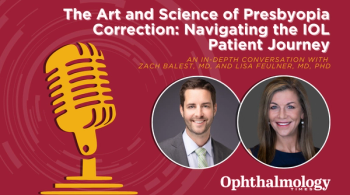
SriniVas Sadda, MD, on high-res OCT of atrophic and precursor lesions in AMD
Improved axial resolution allows clearer visualization of early atrophic changes, including iRORA vs cRORA differentiation, as shared at the Heidelberg 2025 International SPECTRALIS Symposium – And Beyond (ISS).
SriniVas R. Sadda, MD, FARVO, shared insights into the utility of high-resolution optical coherence tomography (OCT) in characterizing atrophic and precursor lesions in age-related macular degeneration (AMD) at the Heidelberg 2025 International SPECTRALIS Symposium – and Beyond (ISS), June 13-14, in Heidelberg, Germany. “We’ve spent a lot of years trying to establish the pathway to the development of atrophy in AMD,” Sadda said, emphasizing the significance of OCT-derived biomarkers like subretinal drusenoid deposits, hyperreflective foci, acquired vitelliform lesions, and thick basal laminar deposits.
These biomarkers are crucial not only for understanding AMD progression but also for identifying candidates for early intervention trials. “Identifying these biomarkers has proven to be quite important… these biomarkers are very important to recognize,” Sadda noted.
A central focus of the presentation was comparing high-resolution OCT with standard-resolution imaging. High-res OCT, with its improved axial resolution, enhances the ability to distinguish key features: “With standard-res OCT you can easily confuse them. With high-res they have a very distinct appearance.” This is especially useful in differentiating true hyperreflective foci from retinal vasculature, as well as in distinguishing between iRORA and cRORA—critical for clinical trial endpoints and real-world risk stratification.
“The brilliance of high-res OCT is that the RPE and Bruch’s membrane are really resolved in tremendous detail,” Sadda said. This resolution allows better assessment of residual RPE cells and basal laminar deposits, aiding in nuanced diagnosis and monitoring.
He also highlighted novel findings, including partial RPE preservation over calcific drusen and visualization of Bruch’s membrane dehiscences: “We’re able to see Bruch's membrane cracks, maybe before the development of neovascularization.”
Sadda added: “This type of risk stratification based on biomarkers… I use this in my clinical practice now.”
Newsletter
Don’t miss out—get Ophthalmology Times updates on the latest clinical advancements and expert interviews, straight to your inbox.


















































.png)


